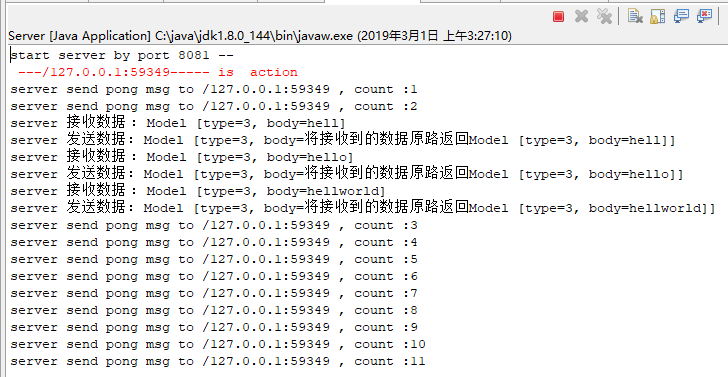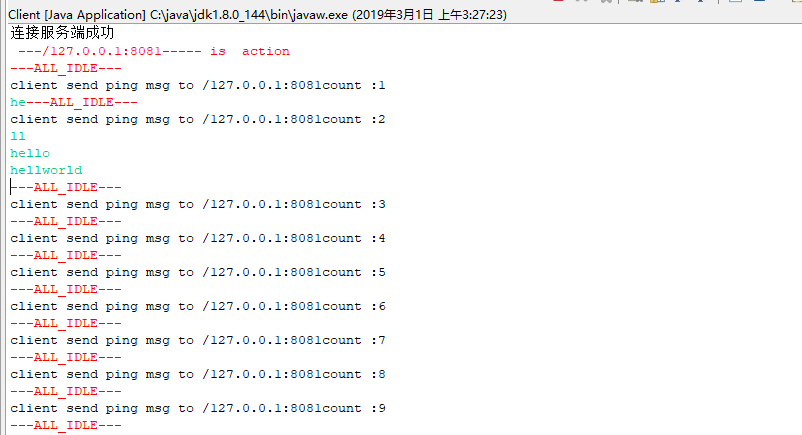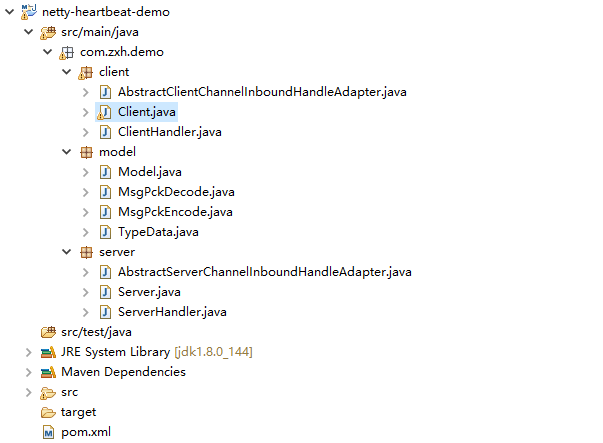标签:作者 private 编程开发 cat method encode like inter lock
本篇demo实现的功能是基于netty的心跳机制和长连接以及重连机制,最关键的就是通过netty中的 IdleStateHandler 的超时机制来实现心跳和重连 ,然后通过org.msgpack编码器来实现跨平台数据传输,
实现的功能就是通过Scanner来输入消息得到服务端的回应,超过设定的超时时间就触发超时事件来进行心跳传输,如果服务端宕机客户端就会一直发起重连。
一、运行效果
服务端:

客户端:

在maven pom文件添加依赖:
<!-- 解码and编码器 -->
<!-- https://mvnrepository.com/artifact/org.msgpack/msgpack -->
<dependency>
<groupId>org.msgpack</groupId>
<artifactId>msgpack</artifactId>
<version>0.6.12</version>
</dependency>
<!-- netty 核心依赖 -->
<!-- https://mvnrepository.com/artifact/io.netty/netty-all -->
<dependency>
<groupId>io.netty</groupId>
<artifactId>netty-all</artifactId>
<version>4.1.33.Final</version>
</dependency>
导入以上依赖 ↓ 创建配置模型model(模型类) , TypeData(参数配置类) ↓ 创建解码and编码器MsgPckDecode(解码器) ,MsgPckEncode(编码器) ↓ 创建各自的控制器 AbstractClientChannelInboundHandleAdapter,AbstractServerChannelInboundHandleAdapter ↓ 创建客户端及客户端控制器Client(客户端启动类) , ClientHandler(客户端控制器) ↓ 创建服务端以及控制器Server(客户端启动类) , ServerHandler(客户端控制器) ps:本demo使用了msgpack , It’s like JSON. but fast and small.
package com.zxh.demo.model;
import java.io.Serializable;
import org.msgpack.annotation.Message;
/**
* 消息类型分离器
* @author Administrator
*
*/
@Message
public class Model implements Serializable{
private static final long serialVersionUID = 1L;
//类型
private int type;
//内容
private String body;
public String getBody() {
return body;
}
public void setBody(String body) {
this.body = body;
}
public int getType() {
return type;
}
public void setType(int type) {
this.type = type;
}
@Override
public String toString() {
return "Model [type=" + type + ", body=" + body + "]";
}
}
编写一个配置类接口,用于控制心跳包和应用消息的处理
package com.zxh.demo.model;
/**
* 配置项
* @author Administrator
*
*/
public interface TypeData {
byte PING = 1;
byte PONG = 2;
//顾客
byte CUSTOMER = 3;
}
创建MsgPckDecode(解码器)
package com.zxh.demo.model;
import java.util.List;
import org.msgpack.MessagePack;
import io.netty.buffer.ByteBuf;
import io.netty.channel.ChannelHandlerContext;
import io.netty.handler.codec.MessageToMessageDecoder;
/**
* 解码器
* @author Administrator
*
*/
public class MsgPckDecode extends MessageToMessageDecoder<ByteBuf>{
@Override
protected void decode(ChannelHandlerContext ctx, ByteBuf msg,
List<Object> out) throws Exception {
final byte[] array;
final int length = msg.readableBytes();
array = new byte[length];
msg.getBytes(msg.readerIndex(), array, 0, length);
MessagePack pack = new MessagePack();
out.add(pack.read(array, Model.class));
}
}
创建MsgPckEncode(编码器)
package com.zxh.demo.model;
import org.msgpack.MessagePack;
import io.netty.buffer.ByteBuf;
import io.netty.channel.ChannelHandlerContext;
import io.netty.handler.codec.MessageToByteEncoder;
/**
* 编码器
* @author Administrator
*
*/
public class MsgPckEncode extends MessageToByteEncoder<Object>{
@Override
protected void encode(ChannelHandlerContext ctx, Object msg, ByteBuf buf)
throws Exception {
// TODO Auto-generated method stub
MessagePack pack = new MessagePack();
byte[] write = pack.write(msg);
buf.writeBytes(write);
}
}
创建client客户端:
package com.zxh.demo.client;
import java.util.Scanner;
import java.util.concurrent.TimeUnit;
import com.zxh.demo.model.Model;
import com.zxh.demo.model.MsgPckDecode;
import com.zxh.demo.model.MsgPckEncode;
import com.zxh.demo.model.TypeData;
import io.netty.bootstrap.Bootstrap;
import io.netty.channel.Channel;
import io.netty.channel.ChannelFuture;
import io.netty.channel.ChannelFutureListener;
import io.netty.channel.ChannelInitializer;
import io.netty.channel.ChannelOption;
import io.netty.channel.ChannelPipeline;
import io.netty.channel.nio.NioEventLoopGroup;
import io.netty.channel.socket.nio.NioSocketChannel;
import io.netty.handler.timeout.IdleStateHandler;
public class Client {
private NioEventLoopGroup worker = new NioEventLoopGroup();
private Channel channel;
private Bootstrap bootstrap;
public static void main(String[] args) {
Client client = new Client();
client.start();
client.sendData();
}
private void start() {
bootstrap = new Bootstrap();
bootstrap.group(worker)
.channel(NioSocketChannel.class)
.option(ChannelOption.TCP_NODELAY, true)
.handler(new ChannelInitializer<Channel>() {
@Override
protected void initChannel(Channel ch) throws Exception {
// TODO Auto-generated method stub
ChannelPipeline pipeline = ch.pipeline();
pipeline.addLast(new IdleStateHandler(0,0,5));
pipeline.addLast(new MsgPckDecode());
pipeline.addLast(new MsgPckEncode());
pipeline.addLast(new ClientHandler(Client.this));
}
});
doConnect();
}
/**
* 连接服务端 and 重连
*/
protected void doConnect() {
if (channel != null && channel.isActive()){
return;
}
ChannelFuture connect = bootstrap.connect("127.0.0.1", 8081);
//实现监听通道连接的方法
connect.addListener(new ChannelFutureListener() {
@Override
public void operationComplete(ChannelFuture channelFuture) throws Exception {
if(channelFuture.isSuccess()){
channel = channelFuture.channel();
System.out.println("连接服务端成功");
}else{
System.out.println("每隔2s重连....");
channelFuture.channel().eventLoop().schedule(new Runnable() {
@Override
public void run() {
doConnect();
}
},2,TimeUnit.SECONDS);
}
}
});
}
/**
* 向服务端发送消息
*/
private void sendData() {
Scanner sc= new Scanner(System.in);
for (int i = 0; i < 1000; i++) {
if(channel != null && channel.isActive()){
//获取一个键盘扫描器
String nextLine = sc.nextLine();
Model model = new Model();
model.setType(TypeData.CUSTOMER);
model.setBody(nextLine);
channel.writeAndFlush(model);
}
}
}
}
创建Server服务端:
package com.zxh.demo.server;
import com.zxh.demo.model.MsgPckDecode;
import com.zxh.demo.model.MsgPckEncode;
import io.netty.bootstrap.ServerBootstrap;
import io.netty.channel.Channel;
import io.netty.channel.ChannelFuture;
import io.netty.channel.ChannelInitializer;
import io.netty.channel.ChannelPipeline;
import io.netty.channel.EventLoopGroup;
import io.netty.channel.nio.NioEventLoopGroup;
import io.netty.channel.socket.nio.NioServerSocketChannel;
import io.netty.handler.timeout.IdleStateHandler;
public class Server {
public static void main(String[] args) {
EventLoopGroup bossGroup = new NioEventLoopGroup(1);
EventLoopGroup workerGroup = new NioEventLoopGroup(4);
try {
ServerBootstrap serverBootstrap = new ServerBootstrap();
serverBootstrap.group(bossGroup, workerGroup)
.channel(NioServerSocketChannel.class)
.localAddress(8081)
.childHandler(new ChannelInitializer<Channel>() {
@Override
protected void initChannel(Channel ch) throws Exception {
// TODO Auto-generated method stub
ChannelPipeline pipeline = ch.pipeline();
pipeline.addLast(new IdleStateHandler(10,0,0));
pipeline.addLast(new MsgPckDecode());
pipeline.addLast(new MsgPckEncode());
pipeline.addLast(new ServerHandler());
}
});
System.out.println("start server by port 8081 --");
ChannelFuture sync = serverBootstrap.bind().sync();
sync.channel().closeFuture().sync();
} catch (InterruptedException e) {
// TODO Auto-generated catch block
e.printStackTrace();
}finally{
//优雅的关闭资源
bossGroup.shutdownGracefully();
workerGroup.shutdownGracefully();
}
}
}
先运行服务端,然后再启动客户端 会根据设置的端口连接服务端,在客户端输入消息就会得到服务端的回应,如果超过5秒没有进行读写就会触发IdleStateHandler类超时事件 来进行心跳包的传输 ,服务端未检测到客户端的读写或者心跳就会主动关闭channel通道
三、项目结构图

所谓的心跳, 即在 TCP 长连接中, 客户端和服务器之间定期发送的一种特殊的数据包, 通知对方自己还在线, 以确保 TCP 连接的有效性.因为网络的不可靠性, 有可能在 TCP 保持长连接的过程中, 由于某些突发情况, 例如网线被拔出, 突然掉电等, 会造成服务器和客户端的连接中断. 在这些突发情况下, 如果恰好服务器和客户端之间没有交互的话, 那么它们是不能在短时间内发现对方已经掉线的. 为了解决这个问题, 我们就需要引入 心跳 机制. 心跳机制的工作原理是: 在服务器和客户端之间一定时间内没有数据交互时, 即处于 idle 状态时, 客户端或服务器会发送一个特殊的数据包给对方, 当接收方收到这个数据报文后, 也立即发送一个特殊的数据报文, 回应发送方, 此即一个 PING-PONG 交互. 自然地, 当某一端收到心跳消息后, 就知道了对方仍然在线, 这就确保 TCP 连接的有效性
标签:作者 private 编程开发 cat method encode like inter lock
原文地址:https://www.cnblogs.com/demodashi/p/10503459.html